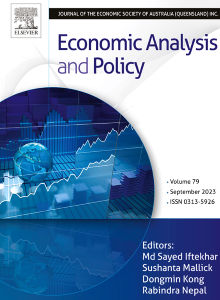Economic and supply chain impacts from energy price shocks in Southeast Asia
IF 7.9
2区 经济学
Q1 ECONOMICS
引用次数: 0
Abstract
Following the war in Ukraine, it became evident that substantial energy price increases had complex impacts on the economic systems and supply chains throughout the Southeast Asian region. In this article, we employ a global applied general equilibrium model (GTAP-E-PowerS) to examine how ongoing energy price increases might affect sectors, economies and emissions levels of the region. We additionally investigate how technological development including energy efficiency gains, utilisation of capital and how output augmenting technologies may help mitigate costs. Our findings indicate demand for renewable energy by private and industrial sectors increase substantially as a substitute for traditional fossil fuels, but are not adequate to compensate for losses. Agriculture and food sectors are not significantly affected, suggesting less hazards to food security as they are not energy-intensive. Manufacturing, transport and electricity generation sectors, which are energy-intensive, are materially adversely affected. More interestingly, however, is the primary energy supply sectors, viz. oil and gas extraction, and petroleum product manufacturing sectors, whose output declines by 20–70 % across countries. Real GDP also declines substantially, by 1.0–3.8 % in the Philippines, Singapore, Vietnam, Indonesia, Malaysia and Thailand. Conversely, total emissions decline by 6–22 % across countries. Of the options considered, investment in improving utilisation of capital resources is found to be the most effective against energy price shocks.
东南亚能源价格冲击对经济和供应链的影响
乌克兰战争之后,能源价格的大幅上涨显然对整个东南亚地区的经济体系和供应链产生了复杂的影响。在本文中,我们采用全球应用一般均衡模型(GTAP-E-PowerS)来研究能源价格的持续上涨会如何影响该地区的行业、经济和排放水平。此外,我们还研究了技术发展,包括能源效率的提高、资本的利用以及产出增加技术如何帮助降低成本。我们的研究结果表明,作为传统化石燃料的替代品,私人和工业部门对可再生能源的需求大幅增加,但不足以弥补损失。农业和食品行业受到的影响不大,这表明由于它们不是能源密集型行业,因此对粮食安全的危害较小。而能源密集型的制造业、运输业和发电业则受到了重大不利影响。但更有趣的是,初级能源供应部门,即石油和天然气开采以及石油产品制造部门,其产出在各国都下降了 20-70%。菲律宾、新加坡、越南、印度尼西亚、马来西亚和泰国的实际 GDP 也大幅下降了 1.0-3.8%。相反,各国的总排放量下降了 6-22%。在所考虑的各种方案中,投资提高资本资源的利用率被认为是应对能源价格冲击最有效的方法。
本文章由计算机程序翻译,如有差异,请以英文原文为准。
求助全文
约1分钟内获得全文
求助全文
来源期刊

Economic Analysis and Policy
ECONOMICS-
CiteScore
9.80
自引率
9.20%
发文量
231
审稿时长
93 days
期刊介绍:
Economic Analysis and Policy (established 1970) publishes articles from all branches of economics with a particular focus on research, theoretical and applied, which has strong policy relevance. The journal also publishes survey articles and empirical replications on key policy issues. Authors are expected to highlight the main insights in a non-technical introduction and in the conclusion.
 求助内容:
求助内容: 应助结果提醒方式:
应助结果提醒方式:


